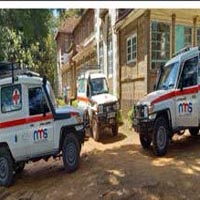Pre-hospital emergency care system: Utilization of ambulance services in Nairobi county

Accepted: 22 November 2021
All claims expressed in this article are solely those of the authors and do not necessarily represent those of their affiliated organizations, or those of the publisher, the editors and the reviewers. Any product that may be evaluated in this article or claim that may be made by its manufacturer is not guaranteed or endorsed by the publisher.
Emergency Medical Service (EMS) is the system that organizes all aspects of medical care provided to patients in the pre-hospital environment and emergency department within hospitals. It comprises agencies and organizations (both private and public), communication and transportation networks, hospitals, highly trained professionals and a public aware on how to respond in emergencies. Kenya needs robust EMS due to the high prevalence of acute medical events such as COVID-19, natural and man-made disasters. The objective of this study was to assess utilization of ambulance services in Nairobi County. The study design was descriptive cross-sectional, using quantitative and qualitative research methods. Data was collected using interviewer-administered semi-structured questionnaires and key in-depth interviews from 14 ambulance services, 19 Emergency Care Centers (ECC), and community. Thirty-nine key informants were sampled using purposive sampling technique and 101 community members sampled using simple random sampling technique from 10 sub-counties. Data tools were pretested at Mukuru Kwa Njenga, a populous slum in Nairobi County. Approval to carry out the study was granted by the Ministry of Health, Kenya. Qualitative data was analyzed using NVIVO12 and quantitative data analyzed using descriptive statistics by use of SPSS vs 25 software. Findings are represented as frequencies and percentages. There were 14 ambulance service providers in the Nairobi Metropolitan Services area with a total of 42 ambulances. Forty-one ambulances were facility-based ambulances. All ambulance services had emergency numbers, and only 3 had short-toll free ambulance access numbers. There were 9 different ambulance dispatch centers in the county. Five ambulance services did not have a dispatch Centre. Public members were the first to assist in in 79% emergencies. There was low public awareness on available pre-hospital emergency care services and tollfree lines for emergency services. Ambulances utilization was also low.
Mistovich J, Hafen B, Karren K. Prehospital emergency care. 8th ed. Brady Prentice Hall Health: USA; 2007.
Waseem H, Naseer R, Razzak J. Establishing a successful pre-hospital emergency service in a developing country: experience from Rescue 1122 service in Pakistan. Emerg Med J 2011;28:513–5. DOI: https://doi.org/10.1136/emj.2010.096271
Onyachi N, Maniple E, Santini S. Preparedness for mass casualties of road traffic crashes in Uganda: assessing the surge capacity of highway general hospitals. Health Policy Dev 2011;9:17–26.
Broccoli M, Calvello E, Skog A. Perceptions of emergency care in Kenyan communities lacking access to formalised emergency medical systems: a qualitative study. BMJ Open 2015;5:e009208. DOI: https://doi.org/10.1136/bmjopen-2015-009208
Koome G, Atela M, Thuita F, Egondi T. Health system factors associated with post-trauma mortality at the prehospital care level in Africa: a scoping review. Trauma Surg Acute Care Open 2020;5:e000530. DOI: https://doi.org/10.1136/tsaco-2020-000530
Macharia W, Njeru E, Muli-Musiime F, Nantulya V. Severe road traffic injuries in Kenya, quality of care and access. Afr Health Sci 2009;9:118–124.
Nicholson B, McCollough C, Wachira B, Mould-Millman NK. Emergency medical services (EMS) training in Kenya: Findings and recommendations from an educational assessment. Afr J Emerg Med 2017;7:157-9. DOI: https://doi.org/10.1016/j.afjem.2017.06.002
Sriram V, Gururaj G, Razzak J. Comparative analysis of three emergency medical services organizations in India and Pakistan. Public Health 2016;137:169–7. DOI: https://doi.org/10.1016/j.puhe.2016.02.022
Stevens KA, Paruk F, Bachani AM, et al. Establishing hospital-based trauma registry systems: lessons from Kenya. Injury 2013;44:S70-S74. DOI: https://doi.org/10.1016/S0020-1383(13)70216-X
Saidi HS. Initial injury care in Nairobi, Kenya: a call for trauma care regionalization. East Afr Med J 2003;80:480-3. DOI: https://doi.org/10.4314/eamj.v80i9.8746
Wachira BW. The state of emergency care in the Republic of Kenya. Afr J Emerg Med 2011;1:160-5. DOI: https://doi.org/10.1016/j.afjem.2011.10.008
Jasper A, Jasper G, Edah I, Edah C. Pre-hospital care of road traffic accident victims in the Niger Delta: a private initiative and experience. Open Access Emerg Med 2019;2019:51-6. DOI: https://doi.org/10.2147/OAEM.S178384
Said H, Kahoro P. Experience with road traffic accident victims at the Nairobi hospital. East Afr Med J 2001;78:441-7. DOI: https://doi.org/10.4314/eamj.v78i8.8999
PAGEPress has chosen to apply the Creative Commons Attribution NonCommercial 4.0 International License (CC BY-NC 4.0) to all manuscripts to be published.


 https://doi.org/10.4081/ecj.2021.10217
https://doi.org/10.4081/ecj.2021.10217







